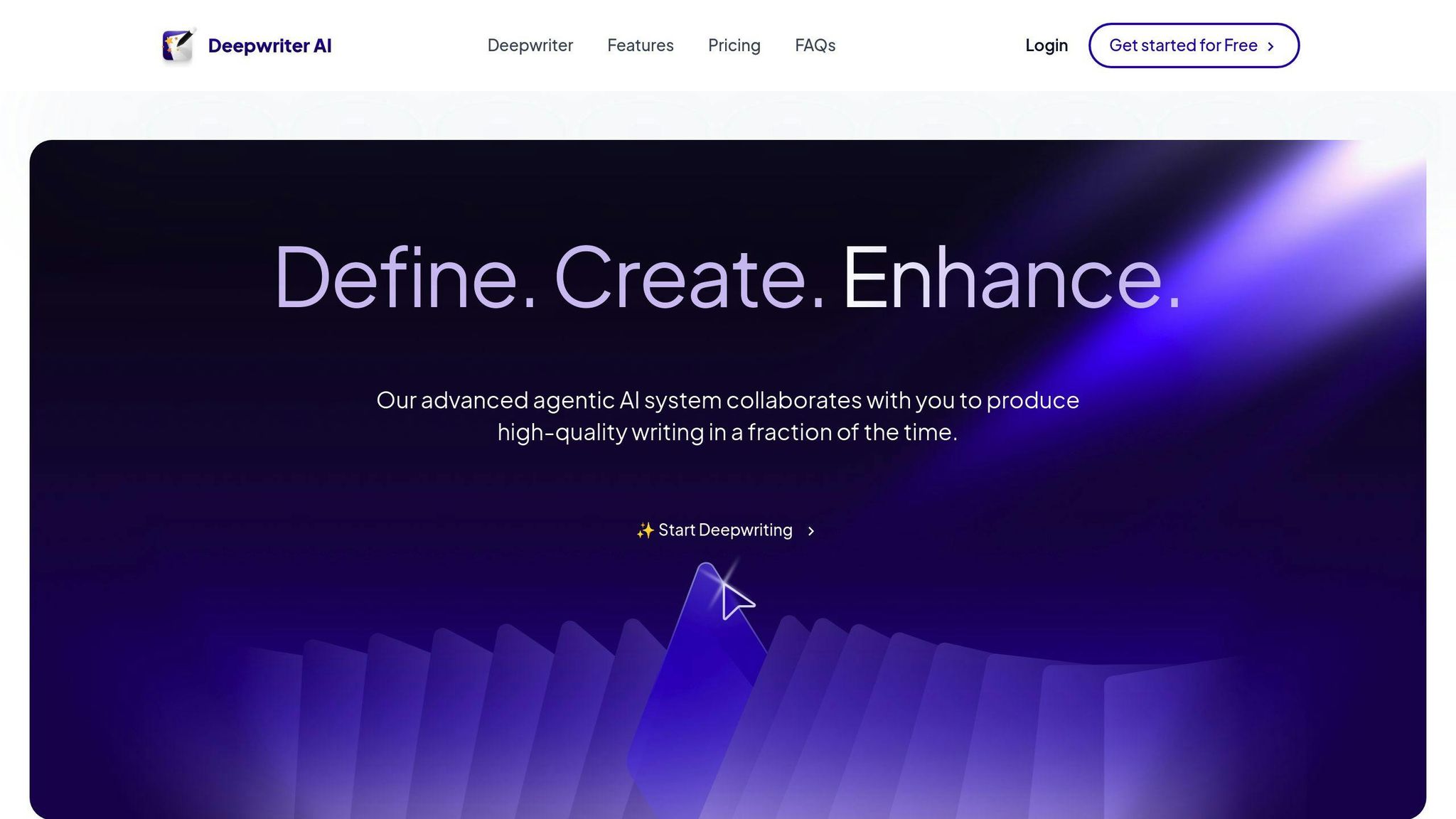AI writing tools often struggle in areas like creativity, emotional depth, and context understanding. Older tools rely on pattern recognition, leading to robotic, repetitive, or disjointed content. Key issues include:
- Content Quality: Outputs lack flow and depth, often requiring heavy editing.
- Creativity: Struggles with storytelling, emotional resonance, and adapting to brand tones.
- Customization: Limited flexibility due to rigid templates and weak learning abilities.
Deepwriter AI addresses these gaps with advanced GPT technology, on-device processing, and customizable features. It enhances narrative flow, supports emotional storytelling, and adapts to diverse writing needs while keeping the writer in control.
Quick Comparison
| Aspect | Traditional AI Writers | Deepwriter AI |
|---|---|---|
| Creative Depth | Limited and generic | Contextual suggestions for better tone |
| Content Quality | Repetitive, lacks cohesion | Tailored models for diverse content |
| User Control | Mostly automated, minimal customization | Writers guide direction |
| Processing | Cloud-based, privacy concerns | Secure, on-device processing |
| Customization | Fixed templates, minimal flexibility | Adjustable settings for various styles |
Bottom Line: Deepwriter AI bridges the gap between automation and human creativity, offering more refined and adaptable solutions for modern content needs.
1. Issues with Older AI Writing Tools
Content Quality
Older AI writing tools often struggle to produce content with depth or a clear narrative. They rely on basic pattern recognition, which limits their ability to fully understand context. While the outputs may be factually accurate, they often miss the mark when it comes to maintaining a cohesive flow. This can result in disjointed paragraphs that feel disconnected, forcing users to spend extra time editing and restructuring the text.
Creativity and Emotional Depth
A major drawback of traditional AI writing tools is their inability to deliver creative or emotionally engaging content. Since they rely heavily on pre-existing data, the results often feel uninspired and repetitive [6]. Common challenges include:
- Lack of original storytelling
- Inability to evoke emotional responses
- Missing cultural relevance
- Difficulty adapting to specific brand tones
Advanced Features and Customization
Another limitation is the lack of flexibility in meeting unique writing needs. These tools often depend on fixed templates, making the content predictable and easy to identify as machine-generated [5][6]. The limited customization options lead to several challenges:
| Limitation | Result |
|---|---|
| Rigid Templates | Produces repetitive, formulaic content |
| Poor Style Adaptation | Struggles to align with specific brand voices |
| Weak Context Understanding | Misses audience-specific nuances |
| Limited Learning Ability | Fails to improve over time |
As content requirements become more complex, these limitations make traditional tools less effective for professionals aiming to create engaging, high-quality material. This gap underscores the demand for advanced tools like Deepwriter AI, which address these issues with smarter solutions.
Related video from YouTube
2. How Deepwriter AI Stands Out

Deepwriter AI takes AI-assisted writing to the next level by tackling the main challenges of older tools. It combines creativity, accuracy, and personalization in a way that feels effortless.
Content Quality
Using advanced GPT technology and custom models, Deepwriter AI helps writers produce clear, contextually rich content. Unlike older tools that often deliver clunky or inconsistent results, this system offers targeted prompts that guide writers in creating meaningful and engaging work – all while staying true to their unique creative style [2][4].
Creativity and Emotional Depth
Deepwriter AI supports storytelling without taking over. Its AI agents assist with building narratives and developing characters, but the writer remains in charge. Where traditional tools often churn out bland or generic content, Deepwriter AI works with the writer to create work that feels personal and expressive [2][4].
Advanced Features and Customization
Deepwriter AI delivers features that go beyond the basics, offering tools designed for modern writers:
| Feature | Benefit |
|---|---|
| On-Device Processing | Keeps your work private and speeds up content creation |
| Specialized Models | Provides tailored help for different writing needs |
| Customizable Modes | Adjusts to fit individual projects and styles |
These options let writers maintain their own voice while working more efficiently [2][4]. Deepwriter AI bridges the gap between outdated tools and the complex demands of today’s creative projects.
Strengths and Weaknesses
Traditional AI tools are helpful for basic tasks but often fall short when it comes to creating nuanced, emotionally engaging content. These tools rely heavily on existing data, which limits their ability to handle complex writing tasks that demand originality and depth.
Deepwriter AI steps in to fill these gaps with advanced features and capabilities. By leveraging contextualized suggestions and cutting-edge GPT technology, it offers more refined content creation while allowing writers to retain creative control [2][4].
Here’s a side-by-side comparison:
| Aspect | Traditional AI Writers | Deepwriter AI |
|---|---|---|
| Creative Depth | Limited originality; struggles with emotional context | Contextual suggestions that enhance creativity and emotional tone |
| Content Quality | Often repetitive and generic | Tailored models for diverse content types |
| User Control | Outputs are mostly automated with few customization options | Writers guide the narrative direction |
| Processing | Cloud-based, raising privacy concerns | Secure, on-device processing |
| Customization | Minimal flexibility for specific needs | Adjustable settings for various writing styles |
Deepwriter AI stands out by balancing automation with human creativity. While traditional tools can produce content that feels impersonal or formulaic [1][3], Deepwriter AI helps writers use AI as an aid without losing their distinctive voice or creative intent [2][4].
That said, even with advanced tools, writers should stay actively involved in the process. Regular reviews and edits are still crucial to ensure the content meets accuracy and quality standards [5][6]. By addressing these challenges, Deepwriter AI equips writers to tackle the increasing demands of modern creative projects.
Conclusion
Most older AI writing tools fall short when it comes to meeting the demands of today’s content creators. However, advanced platforms like Deepwriter AI mark a new chapter in AI-driven writing. These tools use specialized models and smart suggestions to blend automation with a writer’s personal style, allowing for a balance between machine assistance and human input [2][4].
As highlighted in the comparison, tools like Deepwriter AI effectively address the shortcomings of older solutions. The choice of an AI tool can have a major impact on the quality of the content produced, making it crucial to select one that aligns with creative workflows.
For writers aiming to boost both productivity and originality, modern AI tools offer features that help create engaging and context-aware content while keeping the writer’s unique voice intact. By leveraging tools that support creativity, content creators can meet the increasing demands of digital audiences without sacrificing quality or individuality [5][6].
